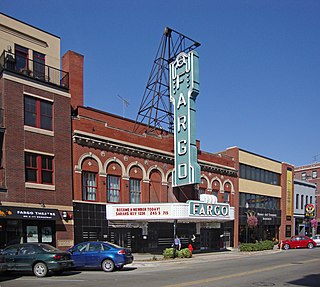
Fargo is a city in and the county seat of Cass County, North Dakota, United States. According to the 2020 census, its population was 125,990, making it the most populous city in the state and the 216th most populous city in the United States. Fargo, along with its twin city of Moorhead, Minnesota, and the adjacent cities of West Fargo, North Dakota and Dilworth, Minnesota, form the core of the Fargo–Moorhead, ND-MN Metropolitan Statistical Area (MSA). The MSA had a population of 248,591 in 2020.

The tornado outbreak of April 6–9, 1998 was a large tornado outbreak that started on April 6 across the Great Plains and ended on April 9 across the Carolinas and Georgia. A total of 62 tornadoes touched down from the Middle Atlantic States to the Midwestern United States and Texas. The outbreak is infamous for producing a deadly F5 that tore through the suburbs of Birmingham, Alabama, killing 32 people. The Birmingham tornado was one of only two F5 tornadoes that year. The other hit in Lawrence County, Tennessee, on April 16, as part of the same outbreak as the Nashville F3 tornado. This tornado outbreak was responsible for 41 deaths: 7 in Georgia and 34 in Alabama.
The Boundary Waters–Canadian Derecho was an international derecho that occurred during the afternoon and evening hours of July 4 and the early morning hours of July 5, 1999. It traveled 1,300 miles (2,092 km) and lasted 22 hours.
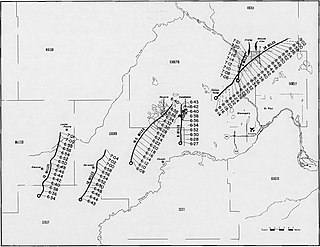
On May 5–8, 1965, a significant tornado outbreak affected much of the Central United States. For four consecutive days, tornado outbreaks produced at least three significant (F2+) tornadoes each day, and at least two violent (F4–F5) tornadoes on three of the four days. The entire sequence generated 37 significant tornadoes, including at least nine violent tornadoes, one of which was rated F5. On May 5, two F4s struck Iowa, including a long-tracked tornado family that injured 11 people. On May 6, an outbreak of six strong tornadoes, four of them violent F4s, affected Minneapolis and St. Paul, Minnesota, and has been nicknamed "The Longest Night", killing 13 people and causing major damages—at the time the most damaging single weather event in Minnesota history. Three of the six tornadoes occurred on the ground simultaneously, and two of them hit the section of Minnesota State Highway 100 and University Avenue in the city of Fridley. Both Fridley tornadoes damaged 1,100 homes and destroyed about 425; total losses reached $14.5 million, $5 million of which was to the Fridley school system.

Shanley High School, is a Catholic high school located in Fargo, North Dakota and operated by the Diocese of Fargo as part of the John Paul II Catholic Schools Network. As of 2014, it served approximately 314 students. Academics are strongly oriented towards college preparatory with approximately 99% of the student body continuing to either a 2 or 4-year degree program. In addition to standard academics courses, student complete required religious education courses during each academic semester.

The Tornado outbreak of June 14–18, 1992 was one of the largest tornado outbreaks on record, affecting portions of the Central United States from June 14 to June 18, 1992. The outbreak began on June 14 when six tornadoes touched down in Colorado and Idaho. Fifty-eight tornadoes were reported across portions of the Great Plains on June 15, and 65 more were reported over much of the central U.S. on June 16. The 123 tornadoes that touched down on June 15–16 make that two-day span the 5th largest two-day tornado outbreak in U.S. history behind the 1974 Super Outbreak, the May 2004 tornado outbreak sequence, the tornado outbreak of April 14–16, 2011, and the 2011 Super Outbreak. Twenty-eight more tornadoes touched down on June 17, and 13 more touched down on June 18, giving this outbreak 170 confirmed tornadoes.
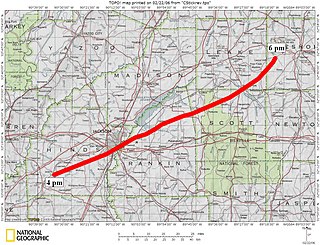
A destructive series of four tornadoes hit the Southeastern United States during March 3-4, 1966. The worst event was a violent and long-lived F5 tornado, dubbed the Candlestick Park tornado after the name of a recently opened Jackson, Mississippi shopping center that was leveled by the storm. The storm would bring catastrophic damage in Mississippi and Alabama along a 202.5-mile (325.9 km) track. The outbreak killed 58, injured 521, and caused $75.552 million in damage.

The Tornado outbreak of June 7–8, 1984 was a significant severe weather and tornado event that took place across the central United States from North Dakota to Kansas on June 7–8, 1984. The tornado outbreak produced several significant tornadoes including an F5 tornado which traveled through Barneveld, Wisconsin, in the early hours of June 8, 1984. The entire outbreak killed at least 13 people across three states including 9 in Barneveld alone.
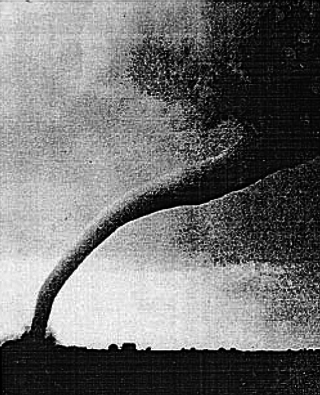
The 1968 Tracy tornado was an extremely powerful tornado that struck Tracy, Minnesota on Thursday, June 13, 1968, at around 7:00 p.m. Rated F5 on the Fujita scale, the tornado killed nine people and injured 125 others. The tornado tracked nine miles (14 km) through Murray, Lyon and Redwood counties in southwestern Minnesota. It is one of only two official F5 tornadoes that have occurred in Minnesota, although several other tornadoes that occurred before 1950 are estimated to have been F5 strength.
The Fargo-Moorhead Twins were a minor league baseball team that existed from 1933 to 1942 and from 1946 to 1960, representing the neighboring cities of Fargo, North Dakota and Moorhead, Minnesota. The Twins won six league championships during their seasons of play. Earlier minor league teams had also represented the cities. Baseball Hall of Fame members Dizzy Dean (1941) and Lloyd Waner (1947) are Fargo-Moorhead Twins alumni, as is 2x AL Most Valuable Player Roger Maris.

Lois Phillips Hudson was an American academic, editor, and novelist.

This page documents the tornadoes and tornado outbreaks of 1993, primarily in the United States. Most tornadoes form in the U.S., although some events may take place internationally. Tornado statistics for older years like this often appear significantly lower than modern years due to fewer reports or confirmed tornadoes, however by the 1990s tornado statistics were coming closer to the numbers we see today.

This page documents the tornadoes and tornado outbreaks of 1996, primarily in the United States. Most tornadoes form in the U.S., although some events may take place internationally. Tornado statistics for older years like this often appear significantly lower than modern years due to fewer reports or confirmed tornadoes, however by the 1990s tornado statistics were coming closer to the numbers we see today.
On December 18–20, 1957, a significant tornado outbreak sequence affected the southern Midwest and the South of the contiguous United States. The outbreak sequence began on the afternoon of December 18, when a low-pressure area approached the southern portions of Missouri and Illinois. Supercells developed and proceeded eastward at horizontal speeds of 40 to 45 miles per hour, yielding what was considered the most severe tornado outbreak in Illinois on record so late in the calendar year. Total losses in the state were estimated to fall within the range of $8–$10 million.

This page documents the tornadoes and tornado outbreaks of 1958, primarily in the United States. Most tornadoes form in the U.S., although some events may take place internationally. Tornado statistics for older years like this often appear significantly lower than modern years due to fewer reports or confirmed tornadoes.

This page documents the tornadoes and tornado outbreaks of 1957, primarily in the United States. Most tornadoes form in the U.S., although some events may take place internationally. Tornado statistics for older years like this often appear significantly lower than modern years due to fewer reports or confirmed tornadoes.
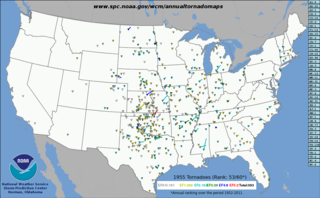
This page documents the tornadoes and tornado outbreaks of 1955, primarily in the United States. Most tornadoes form in the U.S., although some events may take place internationally. Tornado statistics for older years like this often appear significantly lower than modern years due to fewer reports or confirmed tornadoes.

A deadly and destructive outbreak sequence of 23 tornadoes struck parts of the Great Plains and the Great Lakes in late-June 1957. At least seven significant tornadoes (F2+) touched down during the outbreak sequence. The most devastating storm was a large, violent, and catastrophic 500-yard-wide F5 tornado family that struck Fargo, North Dakota on Thursday, June 20, 1957, killing 10 people and becoming the deadliest tornado ever recorded in North Dakota. The outbreak caused 11 fatalities, 105 injuries, and $25.883 million in damage.

This page documents the tornadoes and tornado outbreaks of 1947, primarily in the United States. Most recorded tornadoes form in the U.S., although some events may take place internationally. Tornado statistics for older years like this often appear significantly lower than modern years due to fewer reports or confirmed tornadoes.
The 1944 South Dakota–Minnesota tornado outbreak was a deadly tornado outbreak that occurred on June 17, 1944, in portions of northeastern South Dakota and western Minnesota. The outbreak is known for the Warner-Nahon-Bath Corner-Bath tornado, or just the Bath tornado, which was an F3 that hit the unincorporated community of Bath near Aberdeen, South Dakota, and the Wilmot-Hiawatha Beach-Yankeetown tornado that traveled through four counties from South Dakota into Minnesota. In total, 6 tornadoes were recorded to have touched down, although other less significant touchdowns may have came about. Fatality counts were at 13 people, with an estimated total count of 560 injuries during the outbreak, with most deaths occurring after the main event from debris and unsafe conditions or hazards.
















